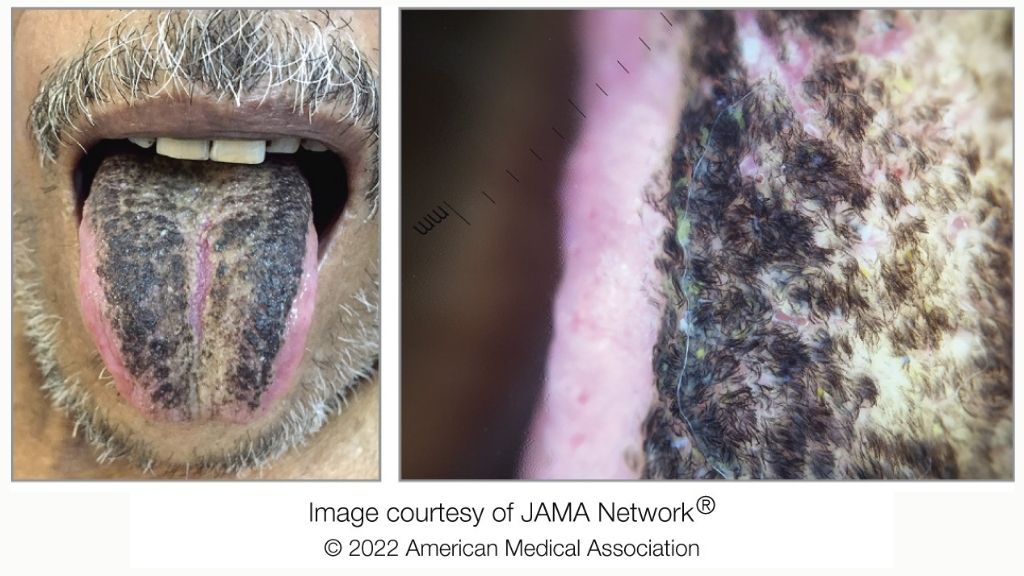Thick, black 'hairs' coated a man's tongue. Here's why.
"Black hairy tongue" is a fairly common condition.

A man went to a dermatology clinic after the top of his tongue became coated in a dense carpet of hairlike fibers. His doctors quickly diagnosed him with a surprisingly common medical condition: "black hairy tongue," known medically as lingua villosa nigra.
Three months prior to his examination, the man, who is in his 50s, had a stroke that caused paralysis on the left side of his body, and his left side still remained weak at the time of his dermatology appointment, according to a new report of the case, published Wednesday (March 9) in the journal JAMA Dermatology. After the stroke, the man was put on a diet of pureed food and liquids, and about two and a half months later, his caretakers noticed "black pigmentation" covering the surface of his tongue.
The thick, black coating was tinged with "yellowish" streaks near the midline and back of the tongue, according to the case report. (The outer edges, tip and dead center of the tongue were free of the gunk, the authors noted.) A closer examination revealed that the black coating was made up of long, thin fibers, with bright, yellow deposits — likely trapped food particles — scattered throughout. The man's doctors also scraped mucus samples from his tongue to check for abnormal bacterial or fungal growth, but they found no such growth when they cultured the scrapings in lab dishes.
Related: 27 oddest medical cases
"With these findings, a diagnosis of black hairy tongue (BHT) was made," they wrote.
Black hairy tongue occurs when tiny, cone-shaped bumps on the surface of the tongue, called filiform papillae, don't shed as they normally do, according to the Cleveland Clinic. These papillae typically grow about 0.04 inch (1 millimeter) long before detaching from the tongue in a process called desquamation. But if the top of the tongue does not undergo regular abrasion — for instance, from a toothbrush, tongue scraper, or solid, textured foods — these papillae can grow to be unusually long — up to about 0.7 inch (18 mm) in length.
For these reasons, poor oral hygiene and a diet of soft foods can raise the risk of developing black hairy tongue. Excessive consumption of coffee, tea, alcohol or tobacco products; certain medications, like antibiotics; radiation treatment of the head and neck; and certain mouthwashes can also disrupt the process of desquamation and drive the condition's onset, according to theCleveland Clinic. Dry mouth is another risk factor, according to the case report.
Sign up for the Live Science daily newsletter now
Get the world’s most fascinating discoveries delivered straight to your inbox.
Related: Should you brush your tongue?
It's thought that the overlong papillae produce keratins, the same proteins found in hair, which contribute to their odd, hairlike appearance, the authors noted. Bacteria, fungi and food particles trapped in the "hairs" also contribute to their color.
"Hairy tongue may appear brown, white, green or pink, depending upon the specific cause and other factors, such as mouthwashes or even candy," the American Academy of Oral Medicine states.
An estimated 13% of people develop black hairy tongue at some point in their lives, although the condition is most common in eldery people, according to the American Academy of Oral Medicine. Thankfully, the condition is usually harmless and short-lived. In the man's recent case, he experienced no pain as a result of the condition, and his black hairy tongue cleared up quickly with simple oral hygiene practices, his doctors noted in the case report.
"The patient and caregivers were given advice regarding proper cleansing measures, and the discoloration resolved after 20 days," the authors said. Generally speaking, "avoidance of predisposing factors and instituting regular cleansing and desquamation measures lead to complete clearance of lesions," they noted.
Originally published on Live Science.

Nicoletta Lanese is the health channel editor at Live Science and was previously a news editor and staff writer at the site. She holds a graduate certificate in science communication from UC Santa Cruz and degrees in neuroscience and dance from the University of Florida. Her work has appeared in The Scientist, Science News, the Mercury News, Mongabay and Stanford Medicine Magazine, among other outlets. Based in NYC, she also remains heavily involved in dance and performs in local choreographers' work.
What are mRNA vaccines, and how do they work?
Deadly motor-neuron disease treated in the womb in world 1st









